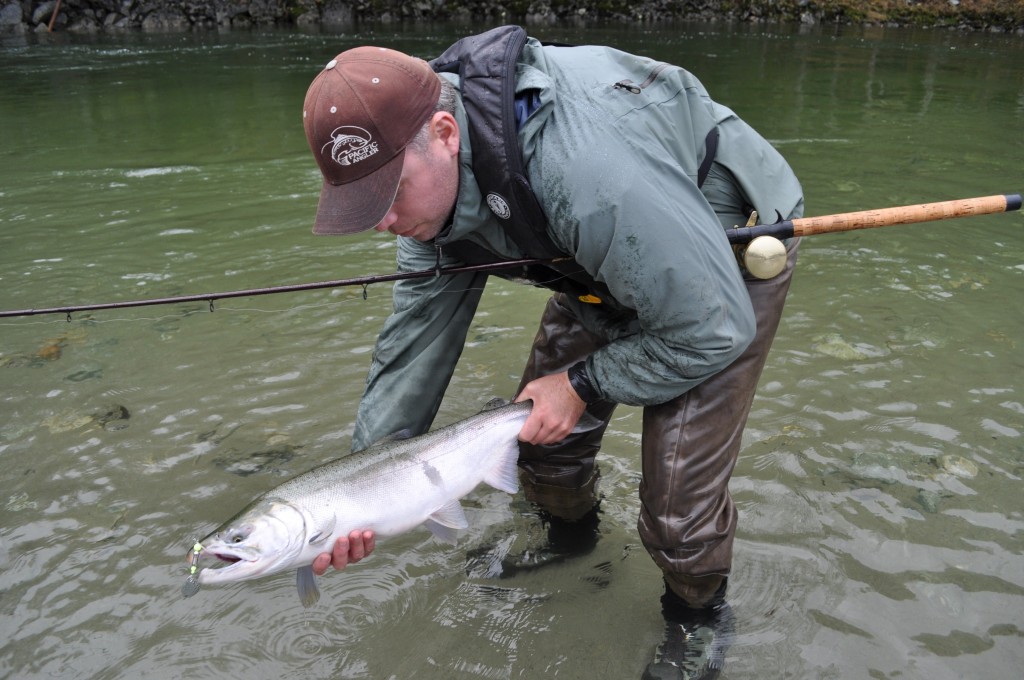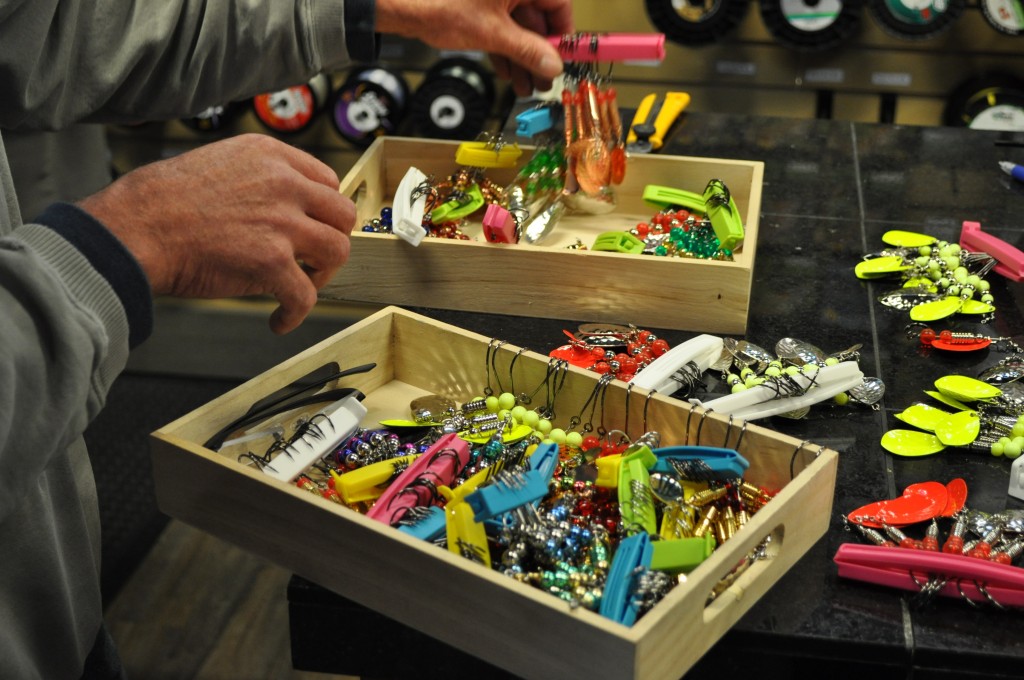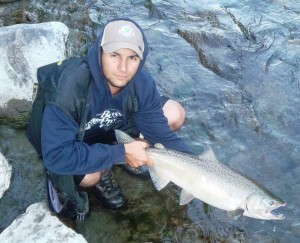Well, the salmon fishing season in our coastal rivers is fast approaching. As a teaser to start to get you thinking about this amazing fishery that is right at our doorstep we would like to publish this short section of our famous “Salmon Fishing in Rivers” course.
One of the most important things to consider in pursuit of salmon in rivers is the water conditions. When heading out to your chosen river you will want to consider the following.
Visibility:
Water visibility varies dramatically in direct correlation to weather systems and is very important to the salmon angler. Visibility tells you where you can expect to find fish and what kind of gear you should be using.
In general rivers will follow a predictable routine of rising and becoming dirty with heavy rain fall or snow melt, reaching a maximum height known as cresting, and dropping and clearing to a point where they eventually become low and clear.
The Rise & High Water: Unfortunately when a river starts to rise dramatically the fishing generally slows down or just plain shuts down as fish start to move and adjust to the changing conditions. The good thing is fresh fish will usually move in and the stale fish in the river will move around and eventually become eager biters on the drop. Until then we need to deal with high, dirty water. As the river crests or just starts to drop there can be some great fishing even in the dirty water.
The dirty water provides overhead cover to the fish so they will be very close to shore resting in the slow water. Compounding this factor is that generally the river is high and running very swift and the best resting water for the fish is going to be right on the beach at your feet.
- Brown or milky green water with less than 2 feet of visibility
- Large, bright profile is key and scent or vibration is also an asset
- Procured roe & prawns
- Silver spoons with fluorescent colors
- Bright yarns to hold scent and add profile
- Chartreuse, Flame, Fl. Pink, Fl. Orange
- Think loonie/toonie size presentations
Since you are using large “bait” you need a large hook to maintain a proper hook gap, a heavy leader to hold fish in the fast water, and a short leader to keep your bait in the zone.
- 1/0 to 3/0 hooks
- 12-18 inch leaders
- 15 lb Maxima Ultragreen, no need to go lighter
Concentrate on slow holding water close to shore and work the area very thoroughly by making multiple casts in the zone. Use heavy gear so you can land the fish once hooked. .
The Drop & Green: Once a river starts to drop it will also start to clear. Rivers that are fed by many tributaries will rise and drop fastest while those fed by lakes will rise slower and drop slower. Knowing how fast a river drops is key to timing when it will be in its “green” stage or when there is 3-6 feet of visibility and the water tends to looks an emerald green. This green stage is generally 2-5 days after the rain stops depending on the river and the freezing level.
In this stage there are fresh fish that moved in with the high water and the fish in the river before the high water have also moved upstream or even downstream in major flood events. With increased visibility fish will move from the shore and toward the deeper water on the current seam where they feel more secure. The clearer the water the more they will move to areas with increased overhead security such as surface disturbance or deeper water. These fish are very eager biters. They are starting to settle into good holding lies and respond eagerly to well presented bait. These conditions are when most people have the best success. Unfortunately they don’t last forever as the river will continue to drop and get clear without more precipitation.
- 3-6 feet visibility with a nice green color
- Spoons with silver, gold colours, matched with a fire stripe
- Single rubber eggs in peach, pink, and orange
- Yarn in peach, pink, red and orange shades
- Roe, roe bags, prawns, shrimp, scents
- Colorado blades in silver, gold or brass, size 3
- Think quarter size presentation to nickel size presentation
We can still use some decent size hooks and leader material but we need a longer leader to distance our bait from out weight.
- 2-1/0 hooks
- 18-24 inch leaders
- 8-12lb Maxima Ultragreen leader material
The range of the holding water has expanded so start at the top of the run close to shore and work your way out and cover the entire run right down to the bottom. Fish can be spread throughout the run but the majority of the fish will be found in the tailout. Fish are often caught quickly so don’t spend too much time in one spot. Cover the water properly. Two or three casts in a likely looking spot is enough to tell you if there are fish there. You will catch more fish by covering more runs than pounding one run too long.
Low & Clear: Once we pass through the green stage we enter into a clear water and eventually low and clear water. This is often the most difficult conditions for the average angler. The fish have often been fished on, they are spooky, and tough to catch. People often think all the fish are gone or have pushed through, but they are there and you need to adjust your techniques to catch them. The key is to scale everything down and look in the spots where fish have maximum overhead cover and depth.
- 6 feet plus visibility
- Scale down everything, small float, small weight, small swivel
- Single rubber eggs in natural colors with a touch of peach or white wool
- Small roe bags
- Dime size pieces of roe or shrimp
- Dime size piece of yarn in peach and softer colors, no fl. colors.
- Colorado blades in brass or copper in size 3 or smaller
The fish can get a good look at your gear so we need to use longer leaders, smaller hooks, and thinner leader material. It’s time to use finesse techniques and expect to get fish in behind those who aren’t scaling things down.
With the smaller baits it pays to cover the water thoroughly but you will also get fish on your first time through as well. I tend to fish faster and hope to find eager fish opposed to staying in one spot and hoping one will eventually bite.
- 2-8 hooks, I use 4 (black or bronze) a lot in low clear water
- 24-36 inch leaders
- 6-8lb Maxima Ultragreen leader material
- 8-10lb Fluorocarbon leader material
If you would like to learn more about salmon fishing in rivers using gear make sure to sign up for our “Fall Salmon River Fishing: Floats, Spinners & Spoons” course in September or October. To reserve a talk to the staff at Pacific Angler by phone (604-872-2204) or drop by the shop.
We would also be more than happy to spend some time with you in the store to show you the ropes and make sure you get the right gear.




